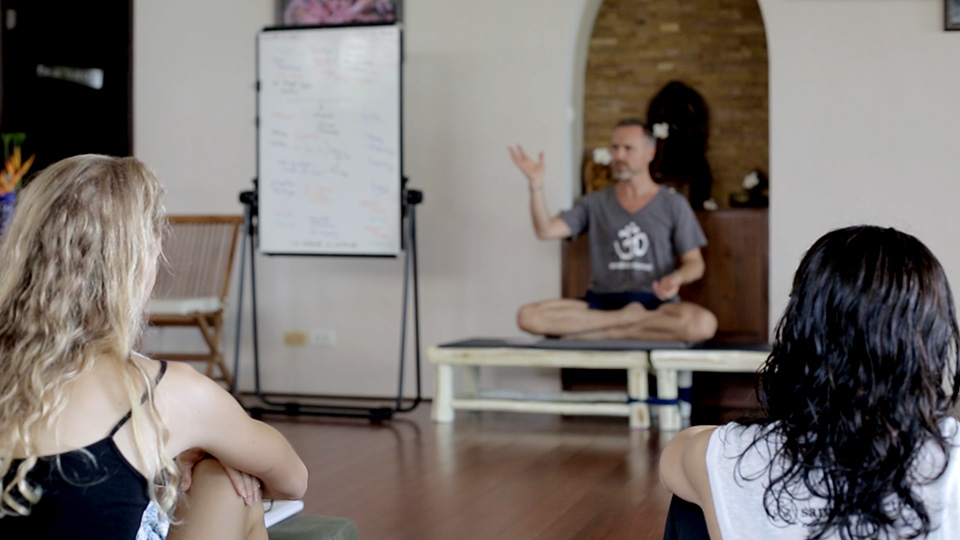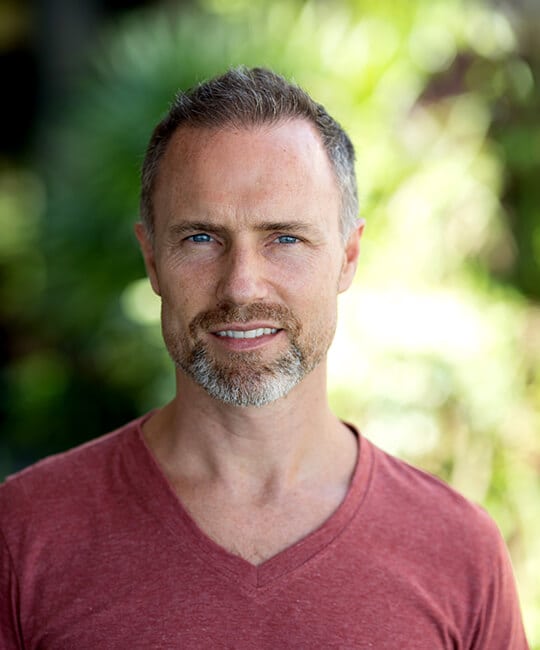ATT-300 Course 4: Breath & Philosophy: The post-Vedic Classical Yoga Tradition & practice of Prānāyāma
Next offered in 2026
Dr. Paul Dallaghan
Overview:
A course for interested students of yoga and those already teaching to expand one’s knowledge and understanding of what Yoga, ‘yoga’, and “yoga” are. Discover how the philosophy of Yoga and later systematization of ‘yoga’ is detailed in the early Classical material of Upanisads, Brahmanical texts, and the Yoga Sutra of Pātanjali. Plus, build and develop your breath-to-prānāyāma practice with an āsana-for-prānāyāma routine, kriyas, and dynamic āsana practice, with ongoing Q&A relating to breath practice. This course fulfills 100-hours of the Advanced TT 300-hours certification and is also a required course within the 600-hour Prānāyāma Teacher Training (PTT) certification.
Course Detail:
This course draws on original texts that relate to Yoga from 700 BCE to 350 CE. This “classical” period is named as such due to Yoga philosophy finding its ground without any apparent system to the dawn of a classical system of yoga that found full expression in the Yoga Sutra of Pātanjali by the fourth-century CE.
Paul’s doctoral research covered at least 60 of these texts in detail, drawing out the origins of certain practices and concepts. This process also revealed the common threads across early yoga teachings that evolved as named traditions to deliver an underlying base of what yoga is and how to achieve it. From this perspective a Yoga philosophy exists with a variety of methods of ‘yoga’, which may also be termed “traditions”, either systematized or not, that modern evolution of “yoga” is typically minimally related to.
The course will use original research materials that include written sections that collate several textual teachings under a relevant topic while at the same time presenting the quoted sources from those texts.
Classical Philosophy Teaching Topics:
Reading materials will be given each morning with the aim that you read it prior to class. This will facilitate a more effective discussion in class which is optimal for learning and comprehension to increase.
- Explanation and exploration of Yoga, ‘yoga’, and “yoga”
- A brief historical overview of Yoga, ‘yoga’ to eventually “yoga”
- The purpose of Yoga according to the classical teachings
- Mind as the base of suffering whereby yoga and its process deliver mental equilibrium
- Three succinct and insightful definitions of Yoga from the Bhagavad Gita
- The ‘Yoga Process’ central concept of going internal, from external to internal, to centered
- The circular and self-fulfilling nature of yoga and its practice
- The Translational Model of Yoga
- Dual-usage terms to identify yoga and its multiple processual approaches
- The three historical time periods in yoga’s development, prior to its modern stage
- Sāmkhya-Yoga explained through selected Kārika’s and Bhagavad Gita verses
- Dualistic principles and the Guna as attributes, dynamic strands, or constituent processes
- The 25 principles of consciousness, materiality and its manifestations to Citta
- Citta as the inner vehicle and a “river of mind that flows in both directions”: states (bhumi), behavior (vrtti), and distortions (klesa)
- The earliest attributable meaning of Yoga as both meditation process and state
- Yoga’s classical definition in the 4th century CE PatanjalaYogaSastra
- The ‘Yoga Process’ as a combination of ubiquitous key components and a systematized method
- The ‘Yoga Process’ as a formula and depicted as a concentric spiral of insight
- Comprehensive Psycho-Physical Yoga’s systematized method’s processual models
- A summary of outcomes from the psycho-physical yoga corpus
Teaching Approach:
The material is delivered through presentations and class discussions of this insightful and highly-researched written material, given to you before class to read in greater or lesser detail. Topics can then be explored and explained and further unpacked based on questions and insights coming from the class.
These courses (4, 5, and 6) are also breath-to-prānāyāma intensives, both in practice and in explanation and discussion of the techniques. It is important to note each module addresses certain aspects of breath and prānāyāma and therefore learning of this deep area occurs over a few years of both class presentation and focused practice. However, each of these courses make time for daily ongoing Q&A relating to prānāyāma practice.
This in-depth study of the formation and understanding of yoga is supported by well-researched written materials that you receive as part of this course. Due to the richness and depth of the course it is possible not every topic is covered within the time allowed. This allows for a range of original material to be presented within this curriculum each time the course is offered on alternating years.
A Typical Day:
Morning practice begins with a short silent sitting followed by an āsana-for-prānāyāma routine. This leads us into sitting practice of meditation techniques. We continue with the practice of some kriyas and build the breathwork-to-prānāyāma practice, based on the classical method outlined in Psycho-Physical (Hatha-Rāja) Yoga, as taught by Centered Yoga at Samahita. The routine to this point is 3-hours of practice in body, breath, and inner focus. For those that want more and enjoy an actice āsana practice we continue with Engaged Dynamic Āsana, alternating between guided class with instruction by the teacher and self-practice, so that the collection of āsanas can be developed in your own time. The afternoon program will be divided between seated energetic center focused meditation, philosophy presentation and discussion, and a day-closing prānāyāma practice session.
Daily Schedule
The program begins at 5pm on the first day of the training with a group welcome. Check out is by 12pm on your last day. The schedule is subject to change at the discretion of the teacher.
| 5:45 am | Beach sunrise silent watch on outdoor beach sala (optional way to start the day) |
| 6:15 – 6:30 am | PULSE /REST: Silent sitting (or savāsana) during pulse analysis (8 students/day) |
| 6:30 am | OFFICIAL MORNING START |
| 6:30– 7:40 am | KRIYAS /ĀSANA /SIT: Opening kriyas followed by a focused āsana routine that supports prānāyāma and sitting practice that leads into sitting for Centered meditative internal practices into silence. |
| 7:40 – 9:10 am | PRĀNĀYĀMA: Focused Detail of Breath, Kriyas and Prānāyāma methods |
| 9:10 – 10:40 am Or when complete (from 20 to 90 mins) |
DYNAMIC ĀSANA: GUIDED EDA: Engaged Dynamic Asana – Guided sequence options or SELF – Teacher Assisted Self-Practice or Restorative Body Breath Practice |
| 10:00 am – 1:30 pm | BRUNCH BUFFET |
| 2.30 – 2:50 pm | Snack and refreshment
Paul available for 1-to-1 chats where necessary, about 10 min’s each, 2-3 a day WORKOUT: Bonus Fun Cycle or Core workout class (20 min’s max) or at 6 pm |
| 3:00 – 3:45 pm | SITTING: Breath regulation to Pranava Japa to silent sitting |
| 3:45 pm | LECTURE with DISCUSSION: following the day’s topic |
| Open time | Q&A: your questions and comments on both practice and philosophy/science |
| Open to 6 / 6:30 pm | PRĀNĀYĀMA: Prānāyāma practice into energy center work & silent sitting |
| 6.00 – 8.00 pm | Complimentary herbal steam room available – great after class with a swim and a beach walk, just before …… DINNER BUFFET |
| 8.00 pm | Your own private time |
Teacher
Dr. Paul Dallaghan
Dr. Paul D. has devoted the last three decades to developing expertise in the field of breath-mind-body lifestyle. He has received a Ph.D. from one of the leading universities in the US, covering both the tradition and science of yoga and breath practices. He has been uniquely acknowledged in the Yoga tradition by the title of “Master Yogi-Prānācharya (expert in breath)”. He has been a dedicated teacher for 25 years and a pioneering entrepreneur establishing the first sustainably-based yoga-breath-meditation retreat center in Asia, Samahita Retreat, in 2003. Paul’s continuous effort is to help people improve their mental and physical health, as a teacher, researcher, and presenter. He is an extremely natural and gifted speaker and has taught and spoken at events all over the world.
See his full bio.
Rates
Rates are in US Dollars, are per person, and are fully inclusive of your chosen room, all buffet meals, use of full facilities, and all training and practices for the duration of the program dates.
| NEW “Inhale” Beachfront Rooms |
Beachfront Private | $4,114 |
| Beachview Private | $3,494 | |
| Beach Private | $3,234 | |
| “Exhale” Gardenview Rooms | Garden Private | $2,714 |
| Garden Semi-Private | $2,454 | |
| Garden Shared Loft | $2,194 |
If you plan to book two or more ATT courses in a row, please email reservations at info@samahitaretreat.com to book your room for the full length of your stay.
Want to extend your stay?
Want to extend your stay?
| Length of Training | Rate per Extra Night for YogaCoreCycle | ||
| Private Room | Semi-Private Room | Shared Two-Bedroom Loft | |
| 2 weeks | $118 / night | $98 / night | $78 / night |
| 4 weeks | $108 / night | $88 / night | $68 / night |
| 6 weeks | $98 / night | $78 / night | $58 / night |
*These discounts also apply to an extended stay on a wellness program.
- Offer valid to a max of 7 nights
- Subject to room availability
- No refunds, changes, or transfers – based on original program booking of 2, 4 or 6 weeks
Confirm your rate and book all extended stays directly with reservations info@samahitaretreat.com
Need to bring a friend, partner or family member?
Subject to availability, we have Friends & Family rates for any registered Samahita Retreat guest’s partner, family member or friend, who is not interested in participating in any of the programs but will stay in a room and board capacity. Shared guest rooms, food, and the facilities are open to them. If they prefer to engage in the selection of yoga, breath, meditation, and fitness classes every day then a separate booking under YogaCoreCycle is advised
Enjoy Our All Inclusive Facilities
Facilities
Samahita RetreatFood
Samahita RetreatGuest Rooms
Samahita RetreatThe Heart of Samahita is found in its impressive mix of facilities that provide the space for your experience, as well as through the food where tasty and healthy merge powerfully, and in our quality mix of guest rooms, where you can stay in the highest of standards right at the beach or find rooms to suit all budgets from beach to garden. And when here you can also paddle board, kayak and snorkel, amongst other activities. Feel free to take a tour and find out where Samahita is located.


